Comparison of Ultra-Rapid Orbit Prediction Strategies for GPS, GLONASS, Galileo and BeiDou
Abstract
1. Introduction
2. Basic Model
3. Data Processing
3.1. Data Collection
3.2. Dynamic Model
4. Results and Discussion
4.1. Orbit Differences
4.2. Helmert Alignment
4.3. Solar Radiation Pressure
5. Conclusions
Supplementary Materials
Acknowledgments
Author Contributions
Conflicts of Interest
References
- Dow, J.M.; Neilan, R.E.; Rizos, C. The International GNSS Service in a changing landscape of Global Navigation Satellite Systems. J. Geod. 2009, 83, 191–198. [Google Scholar] [CrossRef]
- Zumberge, J.F.; Heflin, M.B.; Jefferson, D.C.; Watkins, M.M.; Webb, F.H. Precise point positioning for the efficient and robust analysis of GPS data from large networks. J. Geophys. Res. Solid Earth 1997, 102, 5005–5017. [Google Scholar] [CrossRef]
- Montenbruck, O.; Gill, E.; Kroes, R. Rapid orbit determination of LEO satellites using IGS clock and ephemeris products. GPS Solut. 2005, 9, 226–235. [Google Scholar] [CrossRef]
- Blewitt, G.; Hammond, W.C.; Kreemer, C.; Plag, H.P.; Stein, S.; Okal, E. GPS for real-time earthquake source determination and tsunami warning systems. J. Geod. 2009, 83, 335–343. [Google Scholar] [CrossRef]
- Li, X.; Ge, M.; Dai, X.; Ren, X.; Fritsche, M.; Wickert, J.; Schuh, H. Accuracy and reliability of multi-GNSS real-time precise positioning: GPS, GLONASS, BeiDou, and Galileo. J. Geod. 2015, 89, 607–635. [Google Scholar] [CrossRef]
- Lu, C.; Li, X.; Nilsson, T.; Ning, T.; Heinkelmann, R.; Ge, M.; Glaser, S.; Schuh, H. Real-time retrieval of precipitable water vapor from GPS and BeiDou observations. J. Geod. 2015, 89, 843–856. [Google Scholar] [CrossRef]
- Zhang, W.; Lou, Y.; Gu, S.; Shi, C.; Haase, J.S.; Liu, J. Joint estimation of GPS/BDS real-time clocks and initial results. GPS Solut. 2016, 20, 665–676. [Google Scholar] [CrossRef]
- Springer, T.A.; Hugentobler, U. IGS ultra rapid products for (near-) real-time applications. Phys. Chem. Earth A 2001, 26, 623–628. [Google Scholar] [CrossRef]
- Douša, J. Development of the GLONASS ultra-rapid orbit determination at geodetic observatory pecný. In Geodesy of Planet Earth; IAG Symposia, Series; Kenyon, S., Pacino, M., Marti, U., Eds.; Springer: New York, NY, USA, 2012; pp. 1029–1036. [Google Scholar]
- Dach, R.; Jean, Y. International GNSS Service Technical Report 2012. Available online: https://kb.igs.org/hc/en-us/articles/202391998-Technical-Report-2012 (accessed on 15 April 2013).
- Choi, K.K.; Ray, J.; Griffiths, J.; Bae, T.S. Evaluation of GPS orbit prediction strategies for the IGS Ultra-rapid products. GPS Solut. 2013, 17, 403–412. [Google Scholar] [CrossRef]
- Li, Y.; Gao, Y.; Li, B. An impact analysis of arc length on orbit prediction and clock estimation for PPP ambiguity resolution. GPS Solut. 2015, 19, 201–213. [Google Scholar] [CrossRef]
- China Satellite Navigation Office (CSNO). BeiDou Navigation Satellite System Signal in Space Interface Control Document, Open Service Signal (Version 2.1). Available online: http://www.beidou.gov.cn/attach/2016/11/07/21212.pdf (accessed on 10 December 2016).
- Douša, J. The impact of errors in predicted GPS orbits on zenith troposphere delay estimation. GPS Solut. 2010, 14, 229–239. [Google Scholar] [CrossRef]
- Morabito, D.D.; Eubanks, T.M.; Steppe, J.A. Kalman filtering of Earth orientation changes. In Earth’s Rotation and Reference Frames for Geodesy and Geodynamics, Proceedings of the 128th Symposium of the International Astronomical Union, Coolfont, WV, USA, 20–24 October 1986; Kluwer Academic: Nowell, MA, USA, 1988; pp. 257–267. [Google Scholar]
- Liu, W.M.; Li, Z.R.; Liu, W.X.; Wang, F.X. Influence of EOP Prediction Errors on Orbit Prediction of Navigation Satellites. J. GNSS 2009, 6, 003. [Google Scholar]
- Liu, J.N.; Ge, M.R. Panda software and its preliminary result of positioning and orbit determination. Wuhan Univ. J. Nat. Sci. 2003, 8, 603–609. [Google Scholar]
- Noll, C.E. The crustal dynamics data information system: A resource to support scientific analysis using space geodesy. Adv. Space Res. 2010, 45, 1421–1440. [Google Scholar] [CrossRef]
- Montenbruck, O.; Steigenberger, P.; Prange, L.; Deng, Z.; Zhao, Q.; Perosanz, F. The Multi-GNSS Experiment (MGEX) of the international GNSS service (IGS)—Achievements, prospects and challenges. Adv. Space Res. 2017, 59, 1671–1697. [Google Scholar] [CrossRef]
- Guo, J.; Xu, X.; Zhao, Q.; Liu, J. Precise orbit determination for quad-constellation satellites at Wuhan University: Strategy, result validation, and comparison. J. Geod. 2016, 90, 143–159. [Google Scholar] [CrossRef]
- Guo, F.; Li, X.; Zhang, X.; Wang, J. Assessment of precise orbit and clock products for Galileo, BeiDou, and QZSS from IGS Multi-GNSS Experiment (MGEX). GPS Solut. 2017, 21, 279–290. [Google Scholar] [CrossRef]
- Fliegel, H.F.; Gallini, T.E.; Swift, E.R. Global positioning system radiation force model for geodetic applications. J. Geophys. Res. Solid Earth 1992, 97, 559–568. [Google Scholar] [CrossRef]
- Fliegel, H.F.; Gallini, T.E. Solar force modeling of block IIR global positioning system satellites. J. Spacecr. Rocket. 1996, 33, 863–866. [Google Scholar] [CrossRef]
- Ziebart, M.; Dare, P. Analytical solar radiation pressure modelling for GLONASS using a pixel array. J. Geod. 2001, 75, 587–599. [Google Scholar] [CrossRef]
- Beutler, G.; Brockmann, E.; Gurtner, W.; Hugentobler, U.; Mervart, L.; Rothacher, M.; Verdun, A. Extended orbit modeling techniques at the CODE processing center of the international GPS service for geodynamics (IGS): Theory and initial results. Manuscr. Geod. 1994, 19, 367–386. [Google Scholar]
- Springer, T.A.; Beutler, G.; Rothacher, M. A new solar radiation pressure model for GPS satellites. GPS Solut. 1999, 2, 50–62. [Google Scholar] [CrossRef]
- Arnold, D.; Meindl, M.; Beutler, G.; Dach, R.; Schaer, S.; Lutz, S.; Prange, L.; Sośnica, K.; Mervart, L.; Jäggi, A. CODE’s new solar radiation pressure model for GNSS orbit determination. J. Geod. 2015, 89, 775–791. [Google Scholar] [CrossRef]
- Rodriguez-Solano, C.J.; Hugentobler, U.; Steigenberger, P. Adjustable box-wing model for solar radiation pressure impacting GPS satellites. Adv. Space Res. 2012, 49, 1113–1128. [Google Scholar] [CrossRef]
- Bar-Sever, Y.; Kuang, D. New empirically derived solar radiation pressure model for global positioning system satellites. IPN Prog. Rep. 2004, 42, 159. [Google Scholar]
- Bar-Sever, Y.; Kuang, D. New empirically derived solar radiation pressure model for global positioning system satellites during eclipse seasons. IPN Prog. Rep. 2004, 42, 160. [Google Scholar]
- Rodriguez-Solano, C.J.; Hugentobler, U.; Steigenberger, P. Impact of Albedo radiation on GPS satellites. In Geodesy for Planet Earth; Springer: Berlin/Heidelberg, Germany, 2012; pp. 113–119. [Google Scholar]
- Pavlis, N.K.; Holmes, S.A.; Kenyon, S.; Factor, J.K. The development and evaluation of the earth gravitational model 2008 (EGM2008). J. Geophys. Res. 2012, 117, 4406. [Google Scholar] [CrossRef]
- Petit, G.; Luzum, B. IERS Conventions (2010); IERS Technical Note 36; Verlagdes Bundesamts für Kartographie und Geodäsie: Frankfurt am Main, Germany, 2010. [Google Scholar]
- Standish, E.M. JPL Planetary and Lunar Ephemerides, DE405/LE405. JPL IOM 1998, 312.F-98-048. Available online: http://iau-comm4.jpl.nasa.gov/de405iom/ (accessed on 1 May 1997).
- Montenbruck, O.; Gill, E. Satellite Orbits: Models, Methods and Applications; Springer Science & Business Media: Berlin, Germany, 2012. [Google Scholar]
- Kouba, J. A simplified yaw-attitude model for eclipsing GPS satellites. GPS Solut. 2009, 13, 1–12. [Google Scholar] [CrossRef]
- Montenbruck, O.; Schmid, R.; Mercier, F.; Steigenberger, P.; Noll, C.; Fatkulin, R.; Kogure, S.; Ganeshan, A.S. GNSS satellite geometry and attitude models. Adv. Space Res. 2015, 56, 1015–1029. [Google Scholar] [CrossRef]
- Dai, X.; Ge, M.; Lou, Y.; Shi, C.; Wickert, J.; Schuh, H. Estimating the yaw-attitude of BDS IGSO and MEO satellites. J. Geod. 2015, 89, 1005–1018. [Google Scholar] [CrossRef]
- Lutz, S.; Beutler, G.; Schaer, S.; Dach, R.; Ggi, J. CODE’s new ultra-rapid orbit and ERP products for the IGS. GPS Solut. 2016, 20, 239–250. [Google Scholar] [CrossRef]
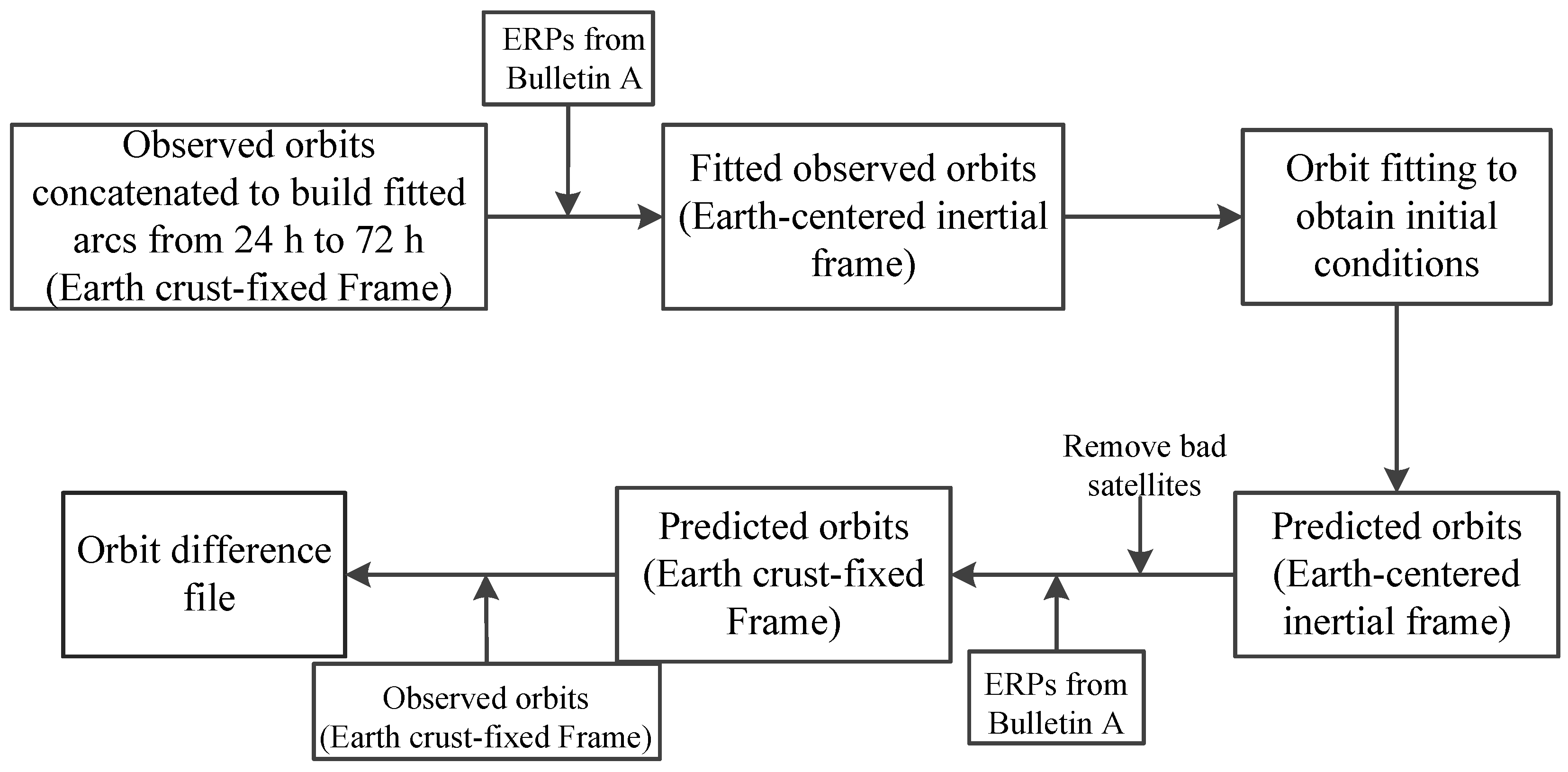

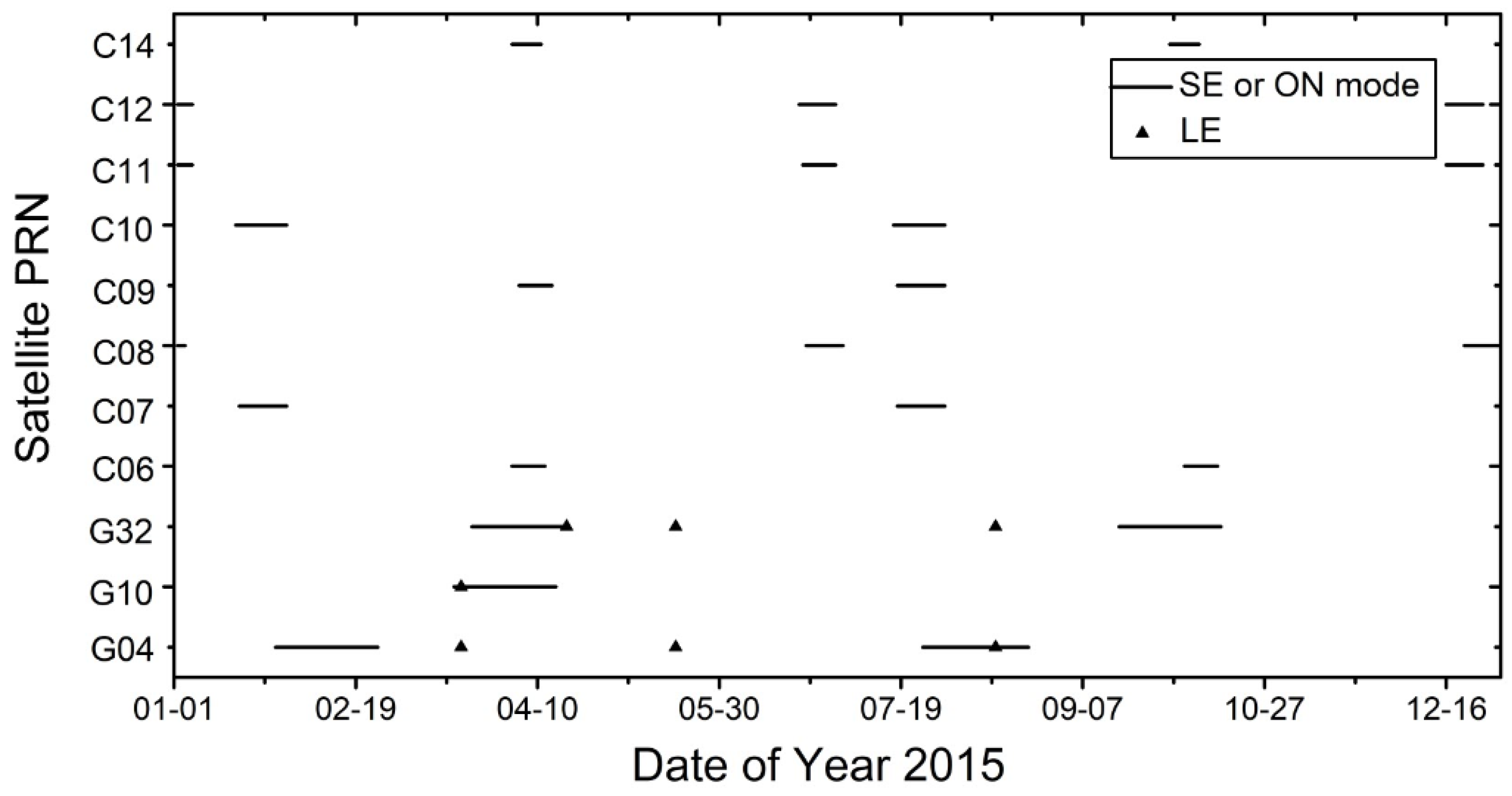

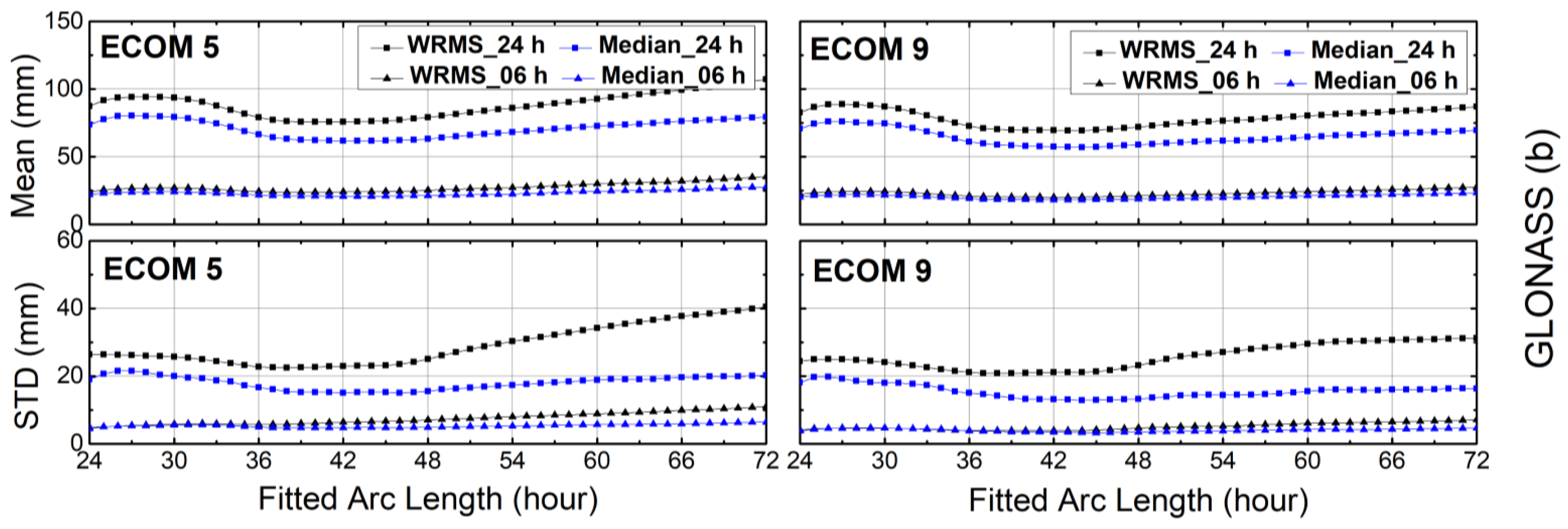
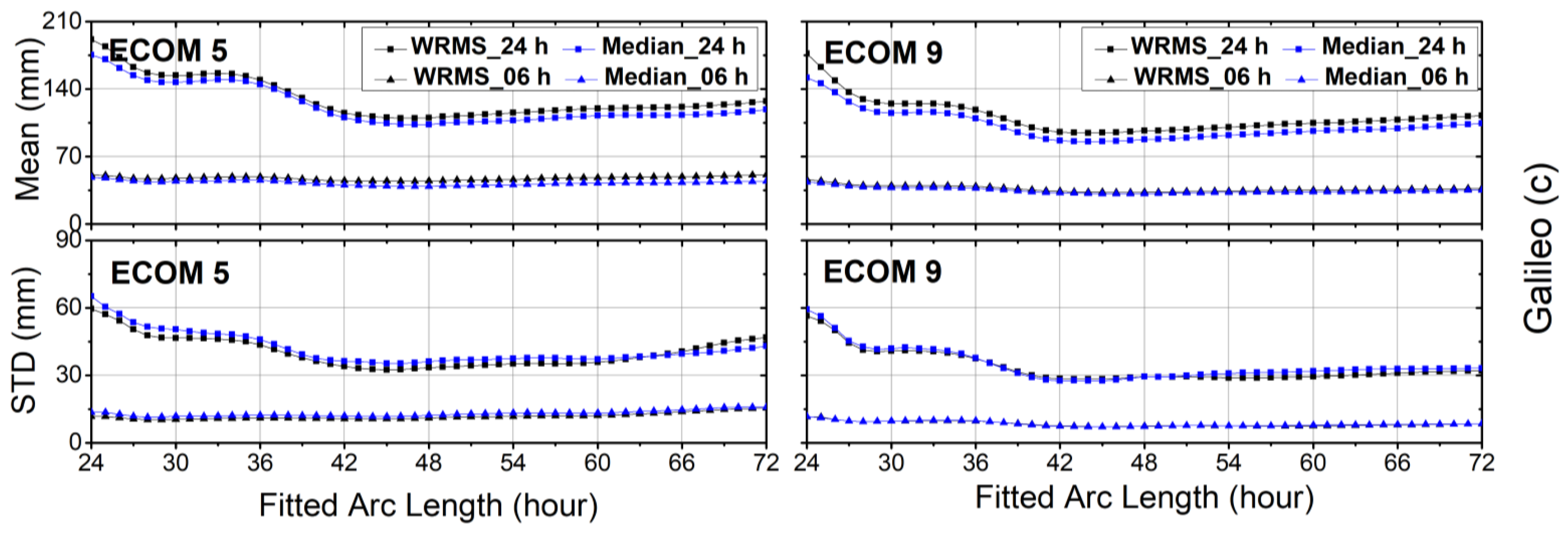
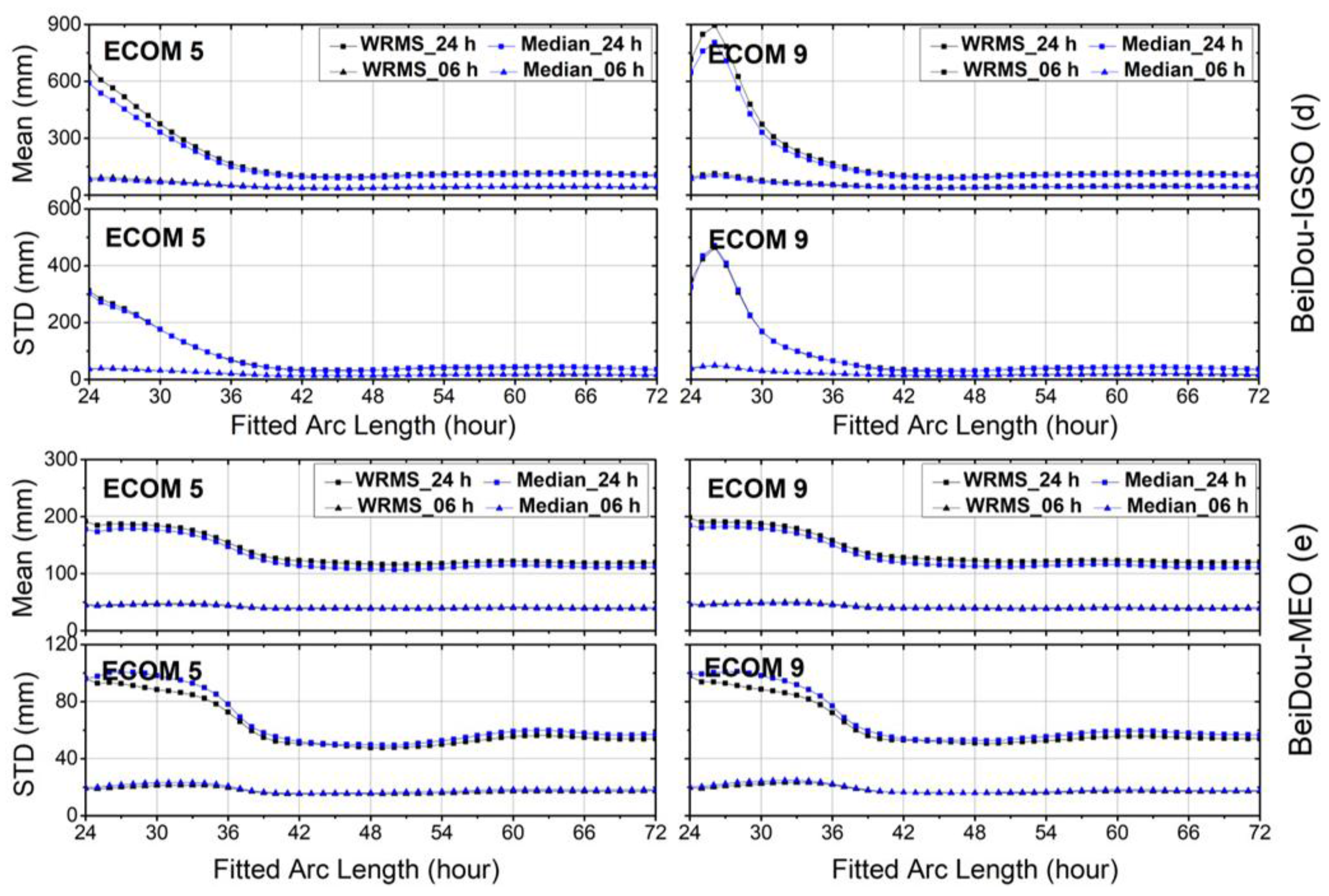
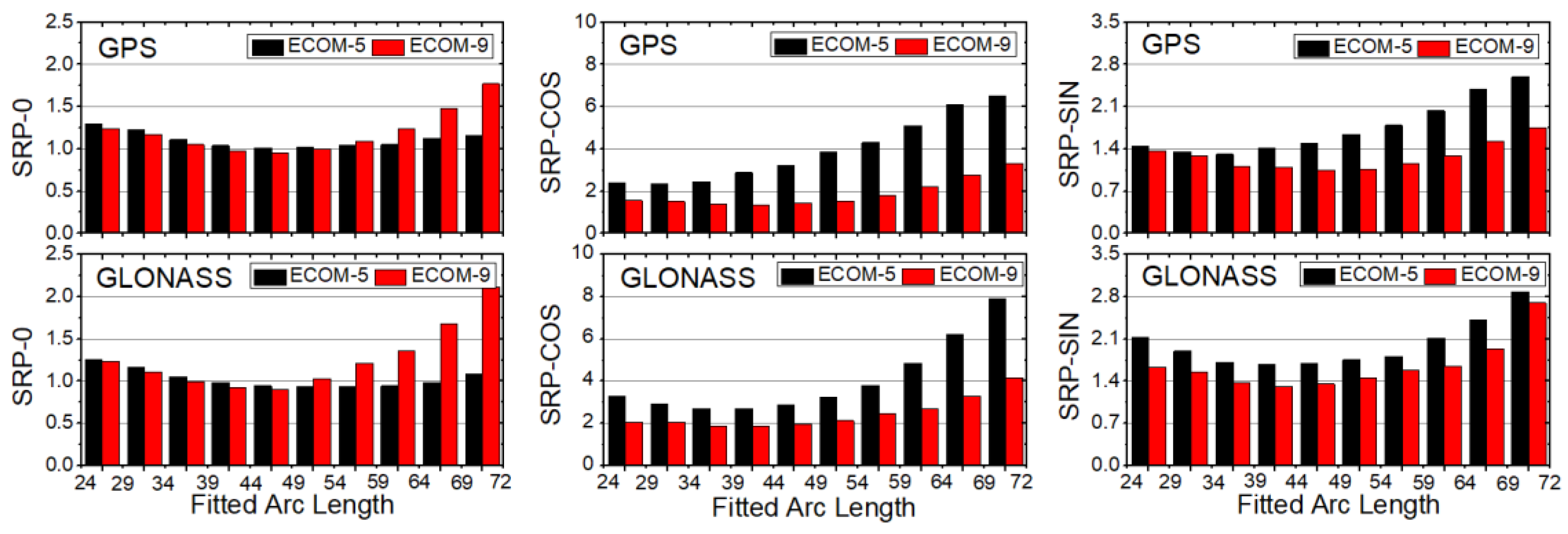
| BDS | Galileo | ||||||
|---|---|---|---|---|---|---|---|
| SVN | PRN | Type | Launched | SVN | PRN | Type | Launched |
| C003 | C01 | GEO | 17 January 2010 | E208 | E08 | FOC | 17 December 2015 |
| C004 | C02 | GEO | 25 October 2012 | E209 | E09 | FOC | 17 December 2015 |
| C004 | C03 | GEO | 2 June 2010 | E101 | E11 | IOV | 21 October 2011 |
| C006 | C04 | GEO | 1 November 2010 | E102 | E12 | IOV | 21 October 2011 |
| C011 | C05 | GEO | 25 February 2012 | E202 | E14 | FOC | 22 August 2014 |
| C005 | C06 | IGSO | 1 August 2010 | E201 | E18 | FOC | 22 August 2014 |
| C007 | C07 | IGSO | 18 December 2010 | E103 | E19 | IOV | 12 October 2012 |
| C008 | C08 | IGSO | 10 April 2011 | E104 | E20 | IOV | 12 October 2012 |
| C009 | C09 | IGSO | 27 July 2011 | E204 | E22 | FOC | 27 May 2015 |
| C010 | C10 | IGSO | 2 December 2011 | E205 | E24 | FOC | 11 September 2015 |
| C012 | C11 | MEO | 30 April 2012 | E203 | E26 | FOC | 27 May 2015 |
| C013 | C12 | MEO | 30 April 2012 | E206 | E30 | FOC | 11 September 2015 |
| C015 | C14 | MEO | 19 September 2012 | ||||
| Integration step-size | 300 s |
| Geopotential (static) | EGM (Earth gravitational model) 2008 [32] up to degree and order 12 |
| Solid earth tides | IERS (International Earth rotation and Reference systems Service) Conventions 2010 (Sun and Moon) [33] |
| Solid earth pole tides | IERS Conventions 2010 |
| Relativistic effects | IERS Conventions 2010 |
| Third-body | JPL (Jet Propulsion Laboratory) DE405 ephemeris used (Sun, Moon, Jupiter, Venus, Mars, Mercury, Uranus, Neptune, Saturn, Pluto, and Charon as point mass) [34] |
| Solar radiation pressure model | ECOM (Empirical Center for Orbit Determination in Europe Orbit Model) |
| Earth radiation model Numerical integration | GPS/GLONASS applied Runge–Kutta–Fehlberg method and Adams–Bashforth and –Moulton method [35] |
| Antenna thrust | Not applied |
| ECOM | GPS | GLONASS | Galileo | BDS (IGSO/MEO) | ||||||
|---|---|---|---|---|---|---|---|---|---|---|
| Mean | STD | Mean | STD | Mean | STD | Mean | STD | |||
| 5 | 24 h | WRMS | 45.9 | 10.8 | 76.0 | 23.0 | 111.4 | 33.0 | 101.4/118.4 | 33.9/48.9 |
| Median | 37.0 | 9.1 | 61.9 | 15.2 | 105.4 | 35.7 | 94.6/109.4 | 32.6/50.5 | ||
| 6 h | WRMS | 15.9 | 3.3 | 24.1 | 6.4 | 44.7 | 10.8 | 39.3/39.9 | 13.2/15.4 | |
| Median | 13.8 | 2.7 | 20.9 | 4.8 | 39.6 | 11.7 | 37.3/38.4 | 13.4/16.1 | ||
| 9 | 24 h | WRMS | 47.1 | 12.6 | 69.6 | 21.1 | 95.3 | 28.6 | 100.6/123.6 | 31.5/51.8 |
| Median | 38.2 | 11.8 | 57.4 | 13.0 | 86.3 | 28.1 | 94.3/114.4 | 31.0/53.4 | ||
| 6 h | WRMS | 14.4 | 3.0 | 20.2 | 3.9 | 33.2 | 7.3 | 40.9/40.2 | 13.7/16.1 | |
| Median | 12.6 | 2.3 | 18.3 | 3.4 | 31.7 | 7.2 | 39.5/38.6 | 15.0/16.2 | ||
| ECOM-5 | ECOM-9 | ||||||||
|---|---|---|---|---|---|---|---|---|---|
| 24 h | 6 h | 24 h | 6 h | ||||||
| Mean | STD | Mean | STD | Mean | STD | Mean | STD | ||
| GPS | 0.3 | 8.2 | 2.3 | 11.5 | 0.6 | 8.6 | 1.0 | 11.8 | |
| −2.4 | 8.1 | −3.6 | 11.5 | −2.0 | 8.5 | −5.6 | 11.5 | ||
| −3.8 | 23.4 | −2.1 | 9.9 | 17.9 | 30.1 | 7.3 | 10.7 | ||
| GLO | −1.4 | 12.8 | −0.8 | 18.1 | 0.3 | 11.4 | −0.2 | 13.9 | |
| 1.6 | 9.4 | 1.1 | 19.9 | 1.7 | 9.2 | 0.5 | 16.7 | ||
| 14.7 | 34.0 | 16.2 | 20.3 | 17.4 | 33.4 | 19.4 | 12.8 | ||
| GAL | −0.3 | 23.5 | 22.9 | 43.4 | −2.9 | 27.4 | 11.0 | 36.3 | |
| 2.0 | 24.3 | 27.5 | 53.4 | 7.0 | 26.9 | 6.4 | 45.7 | ||
| −59.5 | 81.2 | −64.3 | 69.5 | −2.9 | 81.6 | −39.9 | 50.3 | ||
| BD-I | −2.8 | 49.9 | −5.6 | 87.5 | −7.3 | 50.7 | −7.1 | 75.3 | |
| 8.7 | 96.2 | −19.0 | 122.7 | 5.3 | 83.7 | −13.1 | 119.3 | ||
| 20.2 | 146.6 | 11.3 | 169.5 | 12.7 | 169.2 | 20.2 | 204.8 | ||
| BD-M | −3.5 | 38.2 | 12.1 | 72.3 | −4.3 | 35.3 | −13.5 | 70.8 | |
| 5.8 | 37.6 | 3.7 | 72.0 | 5.4 | 35.7 | 0.9 | 67.1 | ||
| −22.4 | 155.3 | −18.1 | 101.5 | −23.0 | 169.8 | −12.7 | 102.4 | ||
© 2018 by the authors. Licensee MDPI, Basel, Switzerland. This article is an open access article distributed under the terms and conditions of the Creative Commons Attribution (CC BY) license (http://creativecommons.org/licenses/by/4.0/).
Share and Cite
Geng, T.; Zhang, P.; Wang, W.; Xie, X. Comparison of Ultra-Rapid Orbit Prediction Strategies for GPS, GLONASS, Galileo and BeiDou. Sensors 2018, 18, 477. https://doi.org/10.3390/s18020477
Geng T, Zhang P, Wang W, Xie X. Comparison of Ultra-Rapid Orbit Prediction Strategies for GPS, GLONASS, Galileo and BeiDou. Sensors. 2018; 18(2):477. https://doi.org/10.3390/s18020477
Chicago/Turabian StyleGeng, Tao, Peng Zhang, Wei Wang, and Xin Xie. 2018. "Comparison of Ultra-Rapid Orbit Prediction Strategies for GPS, GLONASS, Galileo and BeiDou" Sensors 18, no. 2: 477. https://doi.org/10.3390/s18020477
APA StyleGeng, T., Zhang, P., Wang, W., & Xie, X. (2018). Comparison of Ultra-Rapid Orbit Prediction Strategies for GPS, GLONASS, Galileo and BeiDou. Sensors, 18(2), 477. https://doi.org/10.3390/s18020477






